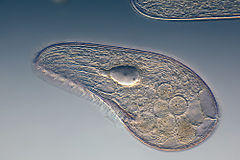| Blepharisma | |
|---|---|

| |
| Blepharisma japonicum | |
| Scientific classification | |
| Domain: | Eukaryota |
| Clade: | Diaphoretickes |
| Clade: | SAR |
| Clade: | Alveolata |
| Phylum: | Ciliophora |
| Class: | Heterotrichea |
| Order: | Heterotrichida |
| Family: | Blepharismidae |
| Genus: | Blepharisma Perty, 1852 |
Blepharisma is a genus of unicellular ciliate protists found in fresh and salt water. The group includes about 40 accepted species, and many sub-varieties and strains. While species vary considerably in size and shape, most are easily identified by their red or pinkish color, which is caused by granules of the pigment blepharismin.[1]
All members of the genus possess a long series of membranelles on the left side of the oral groove, and an "undulating membrane" (a structure resembling a flap, scarf or small sail, composed of long cilia fused together as a single sheet) on the right side of the peristome, toward the posterior.[2]
Certain species of Blepharisma have served as model organisms for scientific research. Since some varieties are easily cultured and readily available from scientific supply houses, they are a common object of study in school science classes.
- ^ Miyake, Akio; et al. (June 29, 1990). "Defensive Function of Pigment Granules in Blepharisma japonicum". European Journal of Protistology. 25 (4): 310–315. doi:10.1016/S0932-4739(11)80122-7. PMID 23196043.
- ^ Hirshfield; et al. (1965). "A proposed organization of the genus Blepharisma Perty and description of four new species". The Journal of Protozoology. 12 (1): 136–144. doi:10.1111/j.1550-7408.1965.tb01826.x.